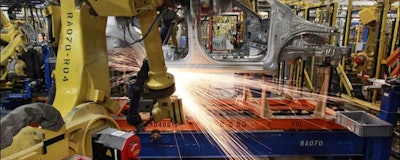
 Kayla Matthews
Kayla MatthewsCountless workers — particularly in the manufacturing sector — are worried they'll soon lose their jobs to industrial automation. While it is true some roles might be phased out — particularly the more menial and monotonous tasks — the current level of integration proves most jobs are likely to remain.
According to some predictions, the increased amount of automation in the manufacturing industry might even lead to increased jobs and greater opportunities in the future.
Disruptive Technologies in Manufacturing
There's no denying next-gen robots are a disruptive technology — but this isn't necessarily a negative thing. Modern technology has been disrupting manufacturing processes ever since the dawn of the Industrial Revolution. Even more recently, we've seen disruptions stem from the inception of the Internet, mobile computing, advanced artificial intelligence and the Internet of Things.
Depending on the timeline, robots appear in multiple instances throughout the history of disruptive technology in manufacturing. In many regards, the fears and concerns over increased industrial automation are nothing new. When self-serve gas pumps hit the mainstream in the 1970s, gas station attendants all across the U.S. lost their jobs. Hundreds of thousands of individuals suddenly found themselves unemployed. Consumers have become so accustomed to the technology they're more than willing to swipe a credit card through an electronic reader for faster service. The concept of the modern gas station — and all the conveniences it offers — has had a substantial and positive effect on society as a whole.
According to recent studies, the United States has lost upwards of 5 million manufacturing jobs since the turn of the 21st century. Despite the decline in available roles, overall productivity and output are steadily increasing. Much of this transformation is a result of increased automation and the rise of a robot-centric workforce.
The Need for Human Workers and Social Interaction
However, it's important to note employers are still looking for candidates with social skills. Roles involving regular social interaction — either with the public or with teammates — increased by more than 10 percent between 1980 and 2012. Since this skill cannot be automated — at least not yet — human workers will still be in demand for the foreseeable future.
There are also some jobs requiring robotic assistance. In automotive construction, for example, robotic arms are used to handle and install heavy components such as engine blocks. Even in this scenario, human workers typically step in to insert bolts and fasteners as necessary.
Other reports tell of a severe shortage of human workers in the manufacturing industry. While some critics of industrial automation cite the number of jobs lost to robotics, there are currently 2 million unfilled positions in manufacturing alone. Making matters worse is the fact that the average manufacturing laborer is 45 years old. It's easy to see how the shortage is likely to continue — and perhaps even increase — as more skilled workers retire in the coming years.
Considering these stats, manufacturers might have no other choice but to seek out increased automation to maintain acceptable levels of productivity and profitability. Given the level of sophistication in industrial robots today, automating an assembly line is easier than ever before.
With advanced AI and machine-learning capabilities, smart factories will soon oversee daily operations through a centralized, automated system. Despite the increasing reliance on next-gen technology, humans will still be required to install, update and repair hardware, program machine operations and ensure output consistency.
But robots aren't taking over the workforce anytime soon — at least not in the United States. Not only is their usage rather confined — primarily to automotive manufacturing — but Japan currently has more industrial robots than all of North America combined.
Changing the Face of Manufacturing — Again and Again
This isn't the first time the manufacturing industry has faced major change. It's not even the first time the manufacturing workforce has felt threatened by industrial automation. History tends to repeat itself, and, as seen in past iterations, society will come out better in the end.
Kayla Matthews is an independent technology writer at Productivity Bytes.






















